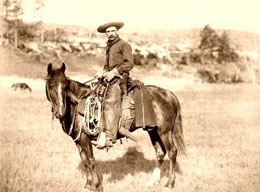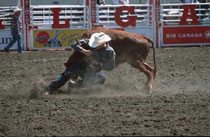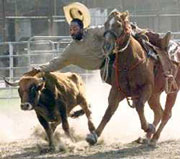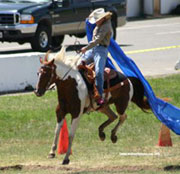影片对白Maybe he's not the marrying kind.
文化面面观
牛仔的生活
在影视作品中,牛仔常常被塑造成英雄的硬汉形象。但实际上,牛仔的生活是非常艰辛的。他们的工作通常都是季节性工作,所以常常是到处找活干,薪水也低。有时为了谋生,不得不从事一些危险的行当,比如牛仔竞技表演等等。

The heirs of ancient pastoral traditions, cowboys have worked as mounted herders on the cattle ranges of the American West for more than three centuries. They first rose to national prominence as an occupational group, however, with the rapid expansion of the western range cattle industry during the second half of the nineteenth century. Cowboy life attracted young, unmarried men, most of them in their late teens and early twenties, from a variety of social and ethnic backgrounds. Whatever their age and upbringing, cowboys, sometimes called "cowhands," "cowpunchers," or "buckaroos," pursued a demanding and sometimes dangerous occupation that required stamina, athleticism, and a specialized knowledge of horses and cattle.
At roundup time cowhands lived undomiciled for months at a time gathering, sorting, branding, and driving cattle. They typically worked in crews consisting of ten or twelve men under the command of a range boss and supported a cook and a chuck wagon, which carried the outfit's food and bedrolls. Each cowboy maintained a string of a half-dozen or more horses, which he changed periodically throughout the work day. Despite toiling long hours, often under difficult conditions, for wages that in the 1880s ranged from $25 to $30 per month, cowboys were self-reliant, fiercely independent, and rarely organized labor unions or engaged in strikes.

Skilled ropers and riders, American cowboys employed tools and techniques perfected by Spanish vaqueros (cowboys) in Mexico and the southwestern United States. They snared livestock with ropes made of rawhide or Manila hemp and rode heavy stock saddles equipped with a horn, which served as a snubbing posts while roping. Cowboys also adopted a distinctive, often colorful style of dress that reflected the requirements of the job, the local work environment, and personal taste. Most wore wide-brimmed hats to protect their head from sun and weather, tall-topped boots with underslung heels to help secure their feet in the saddle stirrups, and spurs, sometimes embellished with silver, to motivate their horses. In brush-infested regions they also donned leather leggings, called chaps, shorthand for the Spanish term chaparejos. Most ranchers, however, banned the wearing of firearms along with drinking and gambling.
During the era of the open range, cowboy work was seasonal, lasting from spring until fall. Ranchers laid off most of their cowboys during the winter months, retaining only a few to keep track of their herds and watch for cattle thieves, many of whom were out-of-work ranch hands. Driving cattle to railhead markets usually fell to separate crews of professional drovers hired by independent contractors.

By the mid-1880s, the open range style of cattle ranching had given way to more organized methods. The advent of barbed wire fences, which divided the range into ever smaller pastures, allowed the separation and upgrading of cattle herds, reduced the number of hands needed to tend them, and changed cowboy life and work forever. In the new order, cowboys were often called upon to cut hay, fix windmills, and build fences as well as ride the range. Married cowboys became more common as twentieth-century advances in transportation and communication and denser settlement patterns mitigated rural isolation. The eventual introduction of motor vehicles and horse trailers which, along with better roads, allowed cowboys to return to their homes and families after each day's work, gradually eliminated chuck wagon–based roundups.

Amid the inexorable economic and social changes that swept away the open range and the unfettered lifestyle of the horseback cowboy, there emerged a more enduring cowboy of legend. By the turn of the twentieth century, literature, art, and popular culture had rescued cowboys from historical anonymity and negative stereotypes and replaced them with a rugged, chivalrous hero. The writings of such authors as Theodore Roosevelt, Owen Wister, and Zane Grey; the art of Frederic Remington and Charles M. Russell; and the theatrics of Buffalo Bill's Wild West show, shaped and polished the image of the cowboy hero, whose independence, individualism, bravery, and common sense became the ideal of American masculinity. Later, motion picture and television portrayals by such actors as William S. Hart, Tom Mix, John Wayne, Gary Cooper, Gene Autry, and Roy Rogers, further defined and reinforced the model, as did countless novels and short stories. The sport of rodeo also played a part in establishing the cowboy's heroic image, while dude ranches offered western tourists the chance to vicariously participate by dressing in western style clothing, riding horses, herding cattle, and imagining the open range. Meanwhile, shrewd merchants and advertisers capitalized on the universal appeal of cow boy imagery to sell a vast array products from cologne to cigarettes. (US History Encyclopedia)
考考你
用今日所学将下面的句子译成英语。
1. 如果我们认为参加合适,我们就会去的。
2. 我累死了,我站了一整天了。
Brokeback Mountain《断背山》精讲之三 考考你 参考答案
1. 这个女人说起话来滔滔不绝,没人能插上话。
The woman talks a blue streak. No one can get a word in with her.
2. 这些看法已经落伍了。
These attitudes are behind the times.
3. I told him it'd take more than chewing gum and baling wire to fix that pickup.
我告诉过他,要修好那辆小货车可不是像嚼口香糖和把电线打捆那么容易。
4. We come out here thinkin' that ranchin' was still big hats and Marlboros.
我们来到这里,以牧场上还是戴着大帽子,就像万宝路广告上那样。
影片对白Maybe he's not the marrying kind.
点击进入:更多精彩电影回顾
(英语点津Annabel编辑)